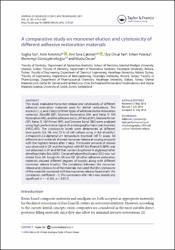| dc.contributor.author | Toz, Tuğba | |
| dc.contributor.author | Kiremitçi, Arlin | |
| dc.contributor.author | Çakmak, Anıl Sera | |
| dc.contributor.author | Ünsal Tan, Oya | |
| dc.contributor.author | Palaska, Erhan | |
| dc.contributor.author | Gümüşderelioğlu, Menemşe | |
| dc.contributor.author | Özcan, Mutlu | |
| dc.date.accessioned | 10.07.201910:49:13 | |
| dc.date.accessioned | 2019-07-10T19:57:13Z | |
| dc.date.available | 10.07.201910:49:13 | |
| dc.date.available | 2019-07-10T19:57:13Z | |
| dc.date.issued | 2017 | en_US |
| dc.identifier.citation | Toz, T., Kiremitçi, A., Çakmak, A. S., Ünsal Tan, O., Palaska, E., Gümüşderelioğlu, M. ve Özcan, M. (2017). A comparative study on monomer elution and cytotoxicity of different adhesive restoration materials. Journal of Adhesion Science and Technology, 31(4), 414-429. https://dx.doi.org/10.1080/01694243.2016.1215768 | en_US |
| dc.identifier.issn | 0169-4243 | |
| dc.identifier.issn | 1568-5616 | |
| dc.identifier.uri | https://dx.doi.org/10.1080/01694243.2016.1215768 | |
| dc.identifier.uri | https://hdl.handle.net/20.500.12511/2926 | |
| dc.description | WOS: 000387925700005 | en_US |
| dc.description.abstract | This study evaluated monomer release and cytotoxicity of different adhesive restoration materials used for dental restorations. The extracts (1, 2, and 7days) of three types of adhesive dental restoration materials, [Quixfill (QF), Silorane Restorative (SR), and Ketac N 100 Restorative (KR)], and the adhesive resins, [XP Bond (XP), Silorane Primer (SP), Ketac N 100 Primer (KP), and Silorane Bond (SB)] were analyzed using high performance liquid chromatography/mass spectrometry (HPLC-MS). The cytotoxicity levels were determined at different time points (24, 48, and 72h) of cell culture using 3-(4,5-dimethyl-2-thiazolyl)-2,5-diphenyl-2H tetrazolium bromide (MTT) assay. All adhesive resin materials showed monomer release at varying amounts with the highest release after 7days. The lowest amount of release was observed in QF and the highest with KP. Bis-Phenol A (BPA) was not detected in SP and KR that contain bisphenol-A diglycidyl ether dimethacrylate (bis-GMA). Decamethylpenthasiloxane (D5) was not eluted from SR. Except for SR and QF, all other adhesive restoration materials showed different degrees of toxicity along with different monomer release kinetics. The correlation between the monomer release and cytotoxicity of the materials indicated that the cytotoxicity of the materials increased with the monomer release (Spearman's rho correlation coefficient - r). The correlation after 48h was statistically significant (r=-0.342, p=0.017). | en_US |
| dc.language.iso | eng | en_US |
| dc.publisher | Taylor & Francis Ltd | en_US |
| dc.rights | info:eu-repo/semantics/openAccess | en_US |
| dc.subject | Adhesion | en_US |
| dc.subject | Cytotoxicity | en_US |
| dc.subject | High-Performance Liquid Chromatography | en_US |
| dc.subject | L929 Cell Culture | en_US |
| dc.subject | Monomer Release | en_US |
| dc.title | A comparative study on monomer elution and cytotoxicity of different adhesive restoration materials | en_US |
| dc.type | article | en_US |
| dc.relation.ispartof | Journal of Adhesion Science and Technology | en_US |
| dc.department | İstanbul Medipol Üniversitesi, Diş Hekimliği Fakültesi, Restoratif Diş Tedavisi Ana Bilim Dalı | en_US |
| dc.identifier.volume | 31 | en_US |
| dc.identifier.issue | 4 | en_US |
| dc.identifier.startpage | 414 | en_US |
| dc.identifier.endpage | 429 | en_US |
| dc.relation.publicationcategory | Makale - Uluslararası Hakemli Dergi - Kurum Öğretim Elemanı | en_US |
| dc.identifier.doi | 10.1080/01694243.2016.1215768 | en_US |
| dc.identifier.wosquality | Q3 | en_US |
| dc.identifier.scopusquality | Q3 | en_US |


















